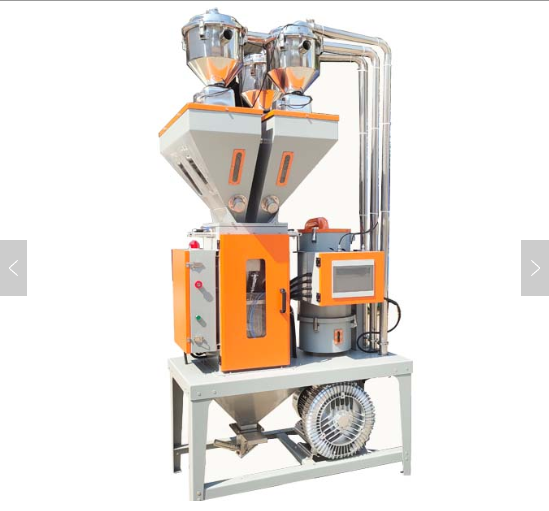|
Central feeding system| RSS
|
|
central feeding system |
 |
central feeding system |
How to solve the problem of head overflow in the central feeding system |
source:Central feeding system Author:Central feeding system time:2020-09-12 14:28:37 |
|||
How to solve the problem of head overflow in the central feeding system The central feeding system adopts a vacuum conveying method. The plastic raw materials are transported from the storage tank to the central dehumidification drying system through a centralized pipeline system, and then the dried raw materials are transported to each injection molding machine. It adopts the design method of "one machine, one pipe" to ensure that the air in the entire system transports the raw materials and prevent the raw materials from regaining moisture after dehumidification and drying. At the same time, it runs stably in each conveying pipeline, and there is generally no blockage. It is used in conjunction with the central dehumidification and drying system, which can clean the conveying pipeline after the dehumidification, drying and delivery cycle to ensure that there are no residual pellets in the pipeline. While avoiding the re-moisture of the raw materials, it also ensures the performance of the raw materials added to the injection molding machine. Consistent. Under the action of vacuum negative pressure, the original dust in the raw material will be filtered out through the dust filter system, which helps to improve the quality of the molded product. The injection molding machine head flash used in the central feeding system is also called flashing, flashing, and piercing, and most of them occur at the opening and closing positions of the mold. Such as: the parting surface of the mold, the sliding part of the slider, the gap of the insert, the hole of the ejector, etc. If the flash is not resolved in time, it will be further enlarged, resulting in a partial collapse of the imprinting mold, causing permanent damage. The flash of the insert gap and the ejector pin pores will also cause the product to be stuck on the mold and affect demolding. 1. Equipment (1) The real clamping force of the machine is insufficient. When selecting an injection molding machine, the rated clamping force of the machine must be higher than the tension formed by the longitudinal projected area of the injection molded product during injection, otherwise it will cause mold expansion and flash. (2) The mold clamping device is not well adjusted, the toggle mechanism is not straight, and the left and right or up and down molds are not balanced, and the parallelism of the mold cannot be achieved. The phenomenon that one side of the mold is tightly closed while the other side is not closely attached , Flash will appear during injection. (3) The mold itself is not parallel well, or installed non-parallel, or the template is not parallel, or the tension rod is unevenly distributed and deformed. These will cause the mold to be not tightly closed and flash. (4) The check ring is severely worn, the spring nozzle spring fails, the barrel or screw is worn too much, the inlet cooling system fails to cause bridging, the barrel set injection volume is insufficient, the cushion is too small, etc. If flashing occurs repeatedly, it must be repaired or replaced in time. 2. Mold (1) Poor precision of mold parting surface. The movable template (such as the middle plate) is deformed and warped; foreign matter is stained on the parting surface or there are protruding skid print burrs on the periphery of the mold frame; the old mold is fatigued and collapsed due to the previous flash extrusion. (2) The mold design is unreasonable. The opening position of the mold cavity is too off, which will cause tension on one side of the mold during injection, causing flash. The fluidity of plastics is too good, such as polyethylene, polypropylene, nylon, etc., in the molten state, the viscosity is very low, and it is easy to enter the movable or fixed gaps, which requires high precision of mold manufacturing. On the premise of not affecting the integrity of the product, it should be placed on the center of mass symmetry as much as possible, and the material should be fed in the thick part of the product to prevent the situation of flashing while lacking material. When there is a molding hole in the center of the product or near it, it is customary to open a side gate on the hole. Because under high injection pressure, if the clamping force is insufficient, the supporting force of the mold in this part will be insufficient and slight warping will occur, resulting in flash. For example, when there are movable components on the side of the mold, the projected area of the side is also affected by the molding pressure. If the supporting force is not enough, it will cause flash. The sliding core has poor matching accuracy, and the offset of the fixed core and cavity installation position will also produce flash. Poor venting of the cavity, no venting groove on the parting surface of the mold, or the venting groove is too shallow, or too deep or too large, or blocked by foreign objects, will cause flash. For multi-cavity molds, attention should be paid to the reasonable design of each runner and gate, otherwise it will cause uneven filling forces and flash. 3. Process aspects of central feeding system (1) The injection pressure is too high or the injection speed is too fast. Due to the high pressure and high speed, the opening force on the mold increases and causes flash. The injection speed and injection time should be adjusted according to the thickness of the product. Thin products should be filled quickly at a high speed, and no injection after filling; thick products should be filled at a low speed, and the skin should be generally fixed before reaching the final pressure. (2) Excessive feeding volume causes flash. It is worth noting that do not inject too much melt in order to prevent the depression, so that the depression may not be able to fill up, but flash will appear. This situation should be resolved by extending the injection time or holding pressure time. (3) Too high temperature of the barrel and nozzle or too high mold temperature will reduce the viscosity of the plastic and increase the fluidity, which will cause flashing under the condition of smooth injection. 4. Raw materials (1) If the plastic viscosity is too high or too low, flash may appear. Plastics with low viscosity, such as nylon, polyethylene, polypropylene, etc., should increase the clamping force; plastics with strong water absorption or water-sensitive plastics will greatly reduce the flow viscosity at high temperatures and increase the possibility of flashing. These plastics must be thoroughly dried; the viscosity of plastics mixed with too much recycled materials will also decrease, and if necessary, replenish the retained components. If the viscosity of the plastic is too high, the flow resistance will increase, and a large back pressure will increase the pressure of the cavity, resulting in insufficient clamping force and flash. (2) Uneven particle size of plastic raw materials will cause the feeding amount to vary, and the parts may be dissatisfied or flash.
|
Central feeding system technology and maintenance |
| Dehumidification dryer | gravimetric blender | plastic granules mixing machine |
 |
 |
 |
| Links: | plastic dryer | Dehumidifying Dryer | gravimetric blender | Central feeding system |
| company name: | Dongguan Machinery Equipment Co., Ltd. |
| Phone/WeChat: | +86-13669807274 | Whatapp: | +86-13669807274 | E-mail: | wto-btb@wto-btb.com |
| Address: | 168 Guangming New Street, Dongcheng District, Dongguan City, Guangdong Province, China |
| Website real name: | Central feeding system | copyright: | Central feeding system |
| industry search: | Central feeding system | Central conveying system | ©2007-2029 @ |